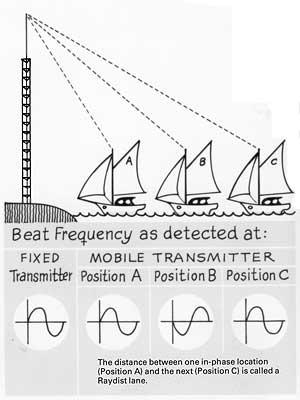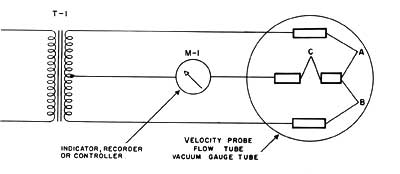How Raydist Works
The general principles underlying Raydist can best be understood by looking first at the simplest form of Raydist, a single range system.

(A) RANGE SYSTEM
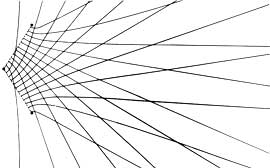
(B) HYPERBOLIC SYSTEM
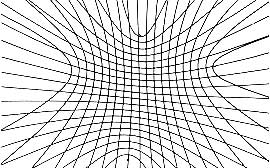
(C) "T" SYSTEM
|
A single range Raydist system uses two CW transmitters at separate locations, each radiating a continuous radio signal. The frequencies of the two signals differ by several hundred cycles per second. These two transmitted signals interact to form a beat frequency equal to the difference between the two original frequencies. (A similar effect occurs when two adjacent notes on a piano are struck simultaneously, creating an audible beating effect.)
This third or beat frequency detected at one transmitter site will typically differ in phase from the same beat frequency detected at the other transmitter site. A comparison of the beat frequency at one transmitter site with that at the other will show the phase relationship of the two signals. This phase relationship can then be used to detect very small changes in distance between the two stations. In practice, the signal received at the fixed transmitter is sent back to the mobile transmitter via a separate communication channel so that phase comparison can take place. (See illustration at lower right.)
As the mobile station moves toward or away from the fixed station, it passes through a series of positions in which the two compared signals are exactly in phase. These in-phase locations form a series of concentric circular lines of position centered on the fixed station.
The distance from one circle to the next is called a Raydist lane. The width of this lane varies according to the particular frequency being used, but in a typical case is about 150 feet.
A single range system gives the user only one line of position. This has application, for example, in determining the speed of a vessel during ship trials. To find his exact location, however, the user must have a second, intersecting line of position from another fixed station. So in practice, two fixed stations are used for a complete range-range system. (See diagram A.)
Since each vessel using the range-range system described must have a transmitter aboard, a maximum of four vessels can use the network at one time. Each uses a slightly different operating frequency.
Unlimited use by any number of vessels can be accomplished by moving the mobile CW transmitter to a suitable location on shore. The vessel then carries only receiving and phase comparison equipment and is completely passive. Any number of vessels can then use the system simultaneously. With this system, the information is no longer direct range with circular coordinates, but lines of equal phase difference that form a grid of hyperbolic coordinates. (See diagram B.)
The area of coverage with good intersections in the three station hyperbolic configuration is more limited than with the range-range system. By adding another transmitter to form a four station network, however, the area of coverage with good intersections is greatly increased. (See diagram C.) This arrangement is called the Raydist T system, and was introduced in 1972. The T system can be extended indefinitely into a chain of Raydist coverage for a long bay or coastline by adding more pairs of transmitters where coverage is required.
How the Hastings Thermopile Works
The unique feature of the Hastings thermopile is that it is compensated for both change and rate of change in temperature. For many applications of the thermopile, this temperature compensation is vitally important.
In the Hastings thermopile, the sensing element is composed of alternate sections of noble metal wires attached to metal studs to form part of a balanced bridge circuit. The basic circuit is shown in the diagram at left. it is powered by an alternating current source, which is stepped down by transformer T-1. The passing of alternating current through the thermopile heats thermocouples A and B and generates a DC voltage. Since the center tap of the transformer and the junction of thermocouples A and B form a balanced AC bridge, only the DC current generated by thermocouples A and B flows in the center. Thermocouple C is not heated and normally does not contribute to the output.
The velocity with which air or gas passes over the thermocouples affects the DC voltage output of the thermocouples. This means that the direct current generated in the thermopile can be passed through an indicating meter (M-1 in the diagram) and used to measure the velocity of the air or gas.
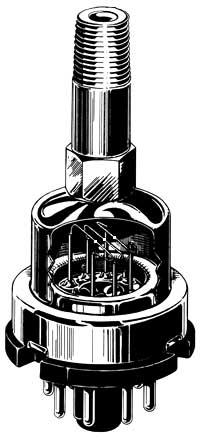
Cutaway view of Hastings vacuum gauge tube showing three thermocouples attached to studs.
|
The thermal conductivity of the air or gas surrounding the thermocouples also affects the DC voltage output they generate. This means that the thermopile can also be used to measure vacuum or absolute pressure, which is directly related to thermal conductivity.
Thermocouple C is unheated by the alternating current, and is used to compensate the thermopile for rate of change in temperature. Its polarity in the circuit is such that any voltage it generates tends to counteract the voltage generated by thermocouples A and B. A sudden rise in ambient temperature, for example, will heat thermocouples A and B much faster than the studs (which act as heat sinks), and cause them to temporarily generate extra voltage. But thermocouple C will be affected by the increased temperature in the same way, and it will temporarily generate a voltage equal and opposite to the extra voltage of A and B until a new temperature equilibrium is reached. Thus the meter will be unaffected by the change in temperature.
How the Investor Fared
The financial success of an investment in Hastings-Raydist can best be appreciated by comparing it with alternative investments. An investor who bought shares in the Hastings Instrument Company when they were first offered to the public in the summer of 1947 could just as easily have invested in such stocks as General Motors, IBM, or Xerox (then known as the Haloid Company).
Twenty-one years later, the HICO investor owned shares in Hastings-Raydist, Inc., and the shares were exchanged for shares in Teledyne, Inc. The figures for July 1947 and March 1968 in the accompanying table show how the HICO investment fared, and compare it with the alternative investments. In addition to the gains shown, each investor received significant cash dividends over the years.
Although inflation during this period was relatively mild compared to its rate during the 1970's, its effects are nevertheless substantial. Using the Consumer Price Index as a guide, a 1968 dollar was worth only $.65 in terms of 1947 dollars. The bottom row of figures for March 1968 shows the value of each investment in terms of constant (1947) dollars. The HICO investment, in constant dollars, was worth $53,142, over fifty times its original value.
Although not in the same league as an investment in the predecessor to Xerox (which, after all, during this period was one of the greatest growth stocks of all time), an investment in Hastings-Raydist paid off handsomely, and was comparable with that in such a successful company as IBM.
In the years since 1968, the Hastings-Raydist investor who held on to his Teledyne stock has fared much better than his counterparts who held stock in the alternative companies. The figures for October 1979 bring up to date the results of the alternative investments first made in 1947. The Teledyne investor did not receive cash dividends while the other investors did, but he fared immensely better. For most investors dividends are less important than capital preservation and appreciation, and by this standard Teledyne has been the only stock of the group to succeed. The last decade had been one of major inflation, and by the fall of 1979 a dollar was worth $.31 in terms of 1947 dollars. While the inflation-corrected values of the other investments have fallen dramatically, the inflation-corrected value of Teledyne stock has doubled!
[February 2010 update, using the Consumer Price Index: in terms of current dollars, a 1947 dollar is the equivalent of $9.72, a 1968 dollar is the equivalent of $6.23, and a 1979 dollar is the equivalent of $2.98.]
Copyright © by Carol Hastings Sanders
|





